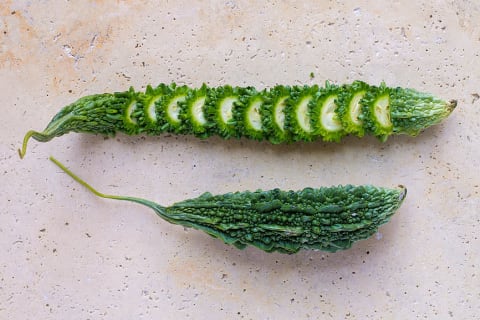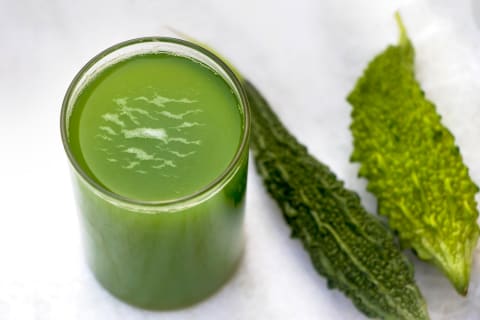The fruit itself is quite bitter, but this is what makes it special (and there are easy ways to make it taste good, which I’ll share later!). It gives many dishes a twist, and in fact, some people crave the taste of bitter melon and swear that it is what gives certain dishes their characteristic flavor. But what makes this fruit even more appealing is its medicinal qualities. It is widely used in traditional and ayurvedic medicine for anything from wound healing to diabetes to digestive and liver support. While there are plenty of drugs to treat diabetes and pre-diabetes, many of them have side effects. I think there is tremendous potential that can be harnessed from traditional medicine and nutritional interventions that can help to reverse pre-diabetes and treat diabetes with fewer side effects. Bitter melon has many promising properties that can potentially play a role. It may be a small fruit, but it’s mighty. Packed with phytonutrients and vitamins, it’s a good source of vitamins C, A, and E. It also is rich in B vitamins, including folate and B2. Additionally, it has potassium, iron, magnesium, and zinc. If that’s not enough, it contains high levels of antioxidants. The medicinal properties of bitter melon are attributed to antioxidant classes2 called phenols, flavonoids, isoflavones, terpenes, anthraquinones, and glucosinolates. These are also the compounds that contribute to the bitter taste of the fruit. The potential healing properties of bitter melon are not limited to anti-diabetic effects. In traditional Chinese medicine, the plant is believed to have anti-inflammatory, anti-mutagen or cholesterol-lowering properties. The fruit, leaves, stems, and roots are all used3 to help treat gastrointestinal disorders, ulcers, kidney stones, liver disease, cancer, infections, psoriasis, menstrual problems, and skin infections and wounds. Bitter melon is believed to have antiviral properties, stimulating the body’s own defense system, and supporting fighting off infections. It is also a popular traditional remedy for malaria due to its anthelmintic properties5. Bitter melon is a true superfood in traditional medicine. Many of the purported properties are not backed by a lot of science, but they are certainly worth looking into as part of a holistic health plan. When cooking with bitter melon, the healing effects tend to be less potent, as some of the nutrients are denatured during the cooking process, though there are still health benefits to be reaped. Pachad, a South Indian creamy cucumber yogurt sauce that contains bitter melon, is considered a medicinal dish for diabetes. The fruit is popular in Indian cuisine: In North India, it’s used in curries and is often served pickled. In South India, it is eaten fried with other vegetables, served with nuts, or in soups. In Chinese cuisine, the fruit is valued for its bitter taste and is usually fried with meat. Bitter melon is a popular ingredient in Okinawan (one of the long-lived Blue Zones) dishes. The fruit is also widely used in Sri Lanka, Indonesia, Vietnam, the Philippines, Pakistan, Bangladesh, Trinidad, and Tobago or Mauritius. In all these cultures, bitter melon is valued for its special taste and healing properties. Want to incorporate bitter melon into your life? Try making this chutney, which you can use to add a burst of flavor to all of your meals!




